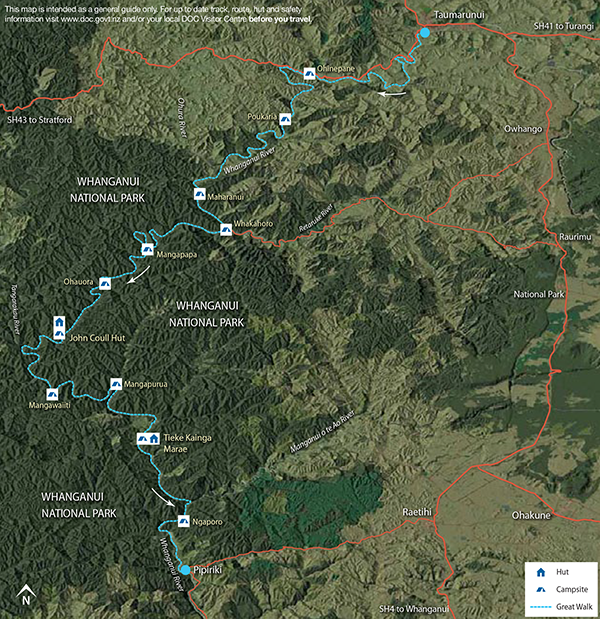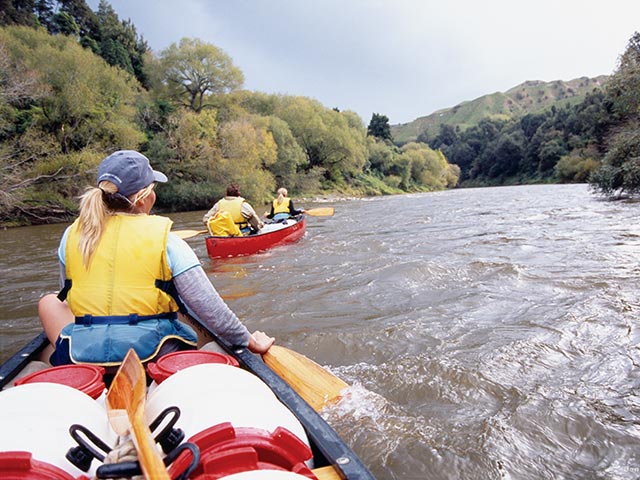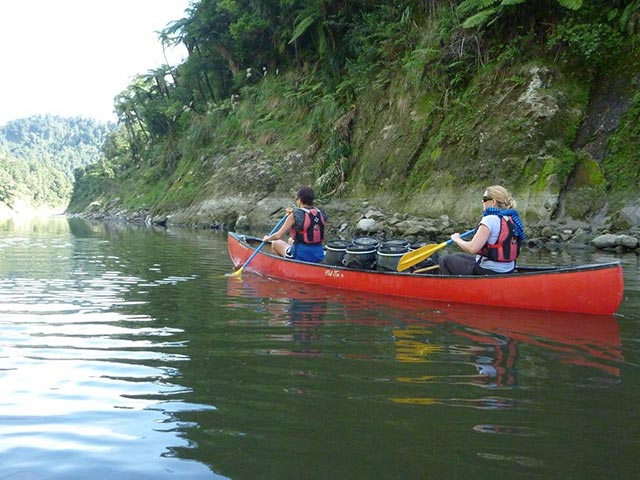Whanganui Journey
The Whanganui Journey begins in the heart of Whanganui National Park
Distance: 88 km / Duration: 3 days
Despite being a river journey, the Whanganui is part of New Zealand’s Great Walks network. The Whanganui River winds its way from the mountains to the Tasman Sea through a landscape of valleys and hills in the central west of the North Island. The journey along the Whanganui River has been documented as far back as 1100AD when Te Atihaunui, a Paparangi people, established themselves. With the arrival of European missionaries in the 1840’s and a regular boat service carrying passengers, mail and freight, boat travel down Whanganui also became a tourism trip.
Now the multi day canoe trip takes visitors through the middle reaches of the river and its surrounding bush covered cliffs and lowland forest which form the heart of Whanganui National Park. You will learn about the powerful connection between the Whanganui iwi and the awa (river) on your journey through remote natural landscapes, historical areas and your stay at Tieke Kainga, the only marae that is also used as a Great Walk Hut. Please Note: due to safety reasons, there is a 2 person minimum to do this journey, unable to book the Whanganui Journey as a solo traveller.
What’s included:
- Package includes 5 days and 4 nights
- Pre and Post Accommodation in a 3 star motel or equivalent in Whakapapa National Park Village (twin share)
- Transportation ex National Park to and from the river
- 3 Day Canoe Hire and Equipment
- 2 nights in Department of Conservation Huts
From NZ$ 404 per person (2 person minimum)
Numbers are limited – Book early to secure your space.
2020/2021 Season is open
Please note the walk is fully booked over the following dates:
- 25, 30 Nov 2020
- 13 Dec 2020
- 25 Dec 2020 – 12 Jan 2021
- 19, 22, 26, 28 Jan 2021
- 04-06, 12-14, 17, 20 Feb 2021
- 11 Mar 2021
- 01-03 Apr 2021
Independent Walking Guide

Day 1
Whakahoro to John Coull Hut
37.5 km / 6.5 – 7 hours
Paddling downstream of Whakahoro you will find yourself amidst bushclad gorges, made more spectacular by numerous waterfalls especially after heavy rain. The middle reaches of the river take you past Mangapapa Campsite and a circular trip around the Kirikiriroa Peninsula and the Tarepokioere Rapid before the wahi tapu ( sacred place) of Tamatea’s Cave. Please respect the cultural significance of the area by not venturing under the overhang of the cave. The Otaihanga Reach past the Ohauora Campsite brings you to your first overnight stop at John Coull Hut. It is strongly advised to bring your canoe or kayak some distance up the bank and tying it to something to avoid losing it if the river rises overnight.
Day 2
John Coull Hut to Tieke Hut
29km / 5 hours
Bush covered hills and the river mouths of the Tangaraku and Whangamomoma as the enter the Whanganui greet paddlers as they meander down this section. A 40 minute side trip is an option with a bush walk from the Mangawaiiti Landing to the Bridge To Nowhere. Downstream from there at Tieke Kainga you can learn about its history and the protocol of its marae and study the intricately carved pou whenua.
Day 3
Tieke Hut to Pipiriki
21.5 km / 4 hours
The magnificent naturally carved gorge of the Manganui o te Ao Riveras it enters the Whanaganui from its path from Mt Ruapehu is one of the highlights of the final stage of your journey. More opportunities for excitement come at the rapids of Ngaporo and Autapu. Exotic trees and farmland follow with your final rapid, the Paparoa, to negotiate before arriving at Pipiriki Village.
More Details On The Walk
What should I bring?
To enjoy freedom walking a spare set of the clothes and underwear you are most comfortable wearing will ensure the hours on the track are a pleasure not a chore. Drying garments in the hut is often not possible for safety reasons so polypropylene and light wool with its fast drying qualities and ability to keep you warm even when it is wet is the most recommended material. Cotton clothing such as jeans, T-shirts and sweatshirts can be a serious liability when wet and have been responsible for a number of hypothermic incidents for hikers caught out in the cold.
Temperatures can vary during the day, with rain, sun and snow possible all on the same day at any time of the year. To ensure your clothing and sleeping bag stays dry we recommend you line your pack with a strong plastic bag before packing your gear into it.
Suggested clothing for the walks
- Warm hat and gloves
- Light weight shoes for around the hut and walking
- Good quality warm wind and rain proof jacket (gortex or similar)
- Sunhat, sunglasses and sunscreen
- Swimming costume and towel
- 2 – 3 sets of fast drying clothing. One set to paddle in and one set to change into at night. Layers of clothing are recommended to manage changing temperatures. It is not possible to dry clothing at the huts.
Personal equipment
- Water bottle
- Sleeping bag and sleeping bag liner
- Toilet gear: toothbrush, toothpaste, toilet paper, small towel, soap
- Torch and spare batteries — There is no lighting at the huts either in the living area or bunkrooms or between huts and ablution blocks.
- Camera (optional)
- Earplugs (optional), but you will be sharing the huts other people
- Plastic bags for wet gear
- First Aid Kit, blister kit, insect repellent, sunscreen, pain relief and bandages, personal medication (e.g. antihistamine for allery to wasp stings etc.)
- Rubbish bag — You must remove all your rubbish from the track
Food must be carried with you and cannot be purchased on the way, suggest cereals for breakfast, crackers, cheese and jam for lunch and instant soup/dried pasta or dehydrated meals for dinner, snacks such as biscuits, muesli bars and tea and coffee. Supermarkets in Whanganui, Taumarunui and Ohakune will be able to supply all your food requirements.
Facilities at your accommodation
- Communal bunkrooms have no pillows or linen and are built with a combination of platform and/or individual bunks with mattresses
- While not five star, the huts you stay in have all the essentials you need for shelter and cooking with sinks, gas cookers, cold water, tables, seating benches and wood burners for heating and as well as solar lighting
- Ablution blocks have flush or vaulted toilets and washbasins with cold water only. Those wishing for showers or baths can enjoy the number of waterfalls or swimming holes on the track.
- A Department of Conservation ranger are present at each hut on the journey
Explore More Today
Weather on the Whanganui Journey is unpredictable, with the potential for the waters to rise rapidly after heavy rain at any time of the year. Travellers need to be prepared for a windy, cold environment.
Travellers are responsible for their own and party members safety. It is crucial you advise others such as family and friends of your intentions, route and dates you are expected to start and return. Severe weather conditions also mean the river will be unsafe to paddle and you may not be able to complete the trip. We recommend a minimum age of 12 years for paddling the river.
Take a moment to watch the short video and explore the maps then you understand why this journey is part of New Zealand’s Great Walks network.

Accommodation sites on the Journey are well marked before the location giving paddlers time to reach the shore. A reasonable standard of fitness is required to paddle the river and negotiate its rapids. The paddling times listed above are approximate times for an average paddler taking short breaks each hour.

 Whanganui Journey
Whanganui Journey Whanganui Journey
Whanganui Journey